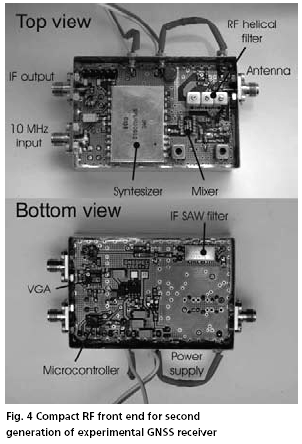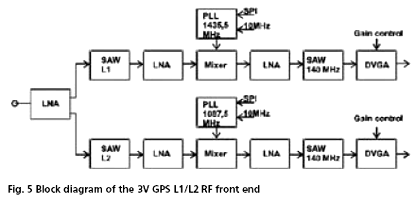| GNSS | |
Design methods for RF part of GNSS software receivers
Compact designA natural process of design optimization led to the more compact RF front end (Fig. 4) for the second generation of experimental GNSS receiver. The intermediated frequency of this front end was increased to 140 MHz to improve suppression of the mirror reception. The helical IF filter was replaced by the SAW filter with much better form factor. The bandwidth of the filter is 16 MHz. The bandwidth of the signal can be further reduced by digital filter in receiver DSP if needed. The complete RF chain with microcontroller for synthesizer control was integrated into one box (50×70 mm) [Spacek (2005)]. The final step was development of the RF front end version for compact version of the receiver for GPS L1 and L2 frequency in euro card (100 x 160 mm) format. The designed compact RF front end has been again revised and 3V technology was used for all parts. The helical RF filters were replaced by the SAW filters. The hybrid synthesizers were replaced by the integrated ADF4360 by Analog Devices controlled by the external inductors. The more compactness of the design and use of unified 3V technology were paid by limited tuning possibility of the synthesizer and lesser flexibility of the design due to necessity of matching RF and IF amplifiers to 50 W. In the case of the use for the different navigation frequency the RF front end must be completely redesigned. The block diagram of such RF front end is in Fig. 5. SummaryThe concrete selection of the design method for RF front end depends on many factors like research aims, available technology and experiences. The simplest way how to design RF front end for experimentation with the GPS/GNSS signals is utilization of the RF front end of lot product receiver. This approach does not require many experiences with RF design. The features of the RF front end are done by manufacture and can be hardly fit to researcher requirements. More flexible approach is a design of the custom made RF front end. The design using GPS/GNSS RF ASIC is easier, but less flexible than the design based on universal RF components and integrated circuits. The most flexible solution is RF front end assembly from replaceable blocks. This approach enables easily modified RF front end characteristic in accordance with the application requirements.The modular design with validated parameters can be then optimized to the compact non-modifiable version. References• Parkinson KJ, Dempster AG, Muford P, Rizos C (2005). FPGA based GPS receiver design considerations. On the CD-ROM of the proceedings of International Symposium on GPS/GNSS 2005, The Hong Kong Polytechnic University, Hong Kong |
|||||||||||||||||||||||||||||
|
|||||||||||||||||||||||||||||
|
Pages: 1 2














 (No Ratings Yet)
(No Ratings Yet)



